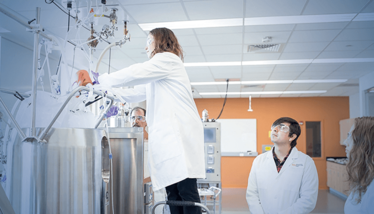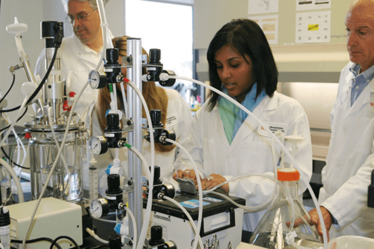Disposing of the Past and Embracing Single-Use Technology
Single-use technology is ready to lend a helping hand to biomanufacturing, but is the industry ready to turn away from stainless steel? A hybrid manufacturing model could benefit from the best of both worlds.

Recently, we spoke with Kamal Rashid, director of the Biomanufacturing Education and Training Center (BETC) at Worcester Polytechnic Institute in Massachusetts, US, about the emerging impact of single-use technologies. Rashid specializes in developing and delivering biotechnology and biomanufacturing training programs and has also been honored with awards for his academic services. BETC combines classroom instruction with hands-on training in a fully functional pilot-scale biomanufacturing facility – which includes single-use technologies. After all, single-use systems could be the future of biomanufacturing so it’s important to train end users how to deploy them effectively.
There is a lot of hype about the potential of biotherapeutics…
The sheer amount of biopharmaceuticals in company pipelines and the amount of bio-related discoveries being made in R&D laboratories worldwide are testament to the fact that we are on the cusp of an exponential growth surge in biomanufacturing. In particular, a lot of promising work is coming from academic labs, which are in a great position to form new ‘spin-off’ firms based on their discoveries or to partner with existing companies to commercialize new products. And there is much more to come: we have only scraped the surface of the potential of biotherapeutics in healthcare.
In 2000, the Human Genome Project announced they’d found more than 30,000 human genes, but we’re still guessing at the function of most of the proteins they encode. And of the proteins that are understood only a small minority have been developed into healthcare products. Parallel to all of the discovery in bioresearch, equipment suppliers have been forging their own path of innovation. This has resulted in game-changing instrumentation and technologies, as well as more efficient media and other materials – all designed to improve biomanufacturing.
It’s amazing how far we’ve come in terms of bioprocess technology. Thinking back to the beginning of my career, when I was working at Penn State University in the 1980s, we had bioreactors that were really quite unsophisticated because the industry was in its infancy at that time. Now, everyone has computer-controlled bioreactors that help manage the processes and are designed to help minimize contamination. These reactors can be cleaned in place and sterilized in place. Many other technical advances have helped the industry, and the latest is the growth of single-use products. I think that this is a really important advance and will play a big part in the industry’s future. But this doesn’t necessarily mean that you need to throw out your stainless steel equipment. There is room for both technologies.
What are the challenges of working with biologics?
Biologics, by definition, are made from cells, but growing a viable population of cells is a tricky business because living entities are infamously temperamental. For new companies, before you can even think about your biomanufacturing facility and bringing in single-use equipment, you need to perform optimization studies with the cell lines that you’re going to be using to ensure you’ll get the amount of cells that you need for the required product output. These tiny cells are the factories that will be producing your product so you must look after them and ensure that the environment is optimized for their growth and duplication.
A lot of variables come into bioproduction and you need to be aware of the potential for contamination throughout the whole manufacturing line – from starting the cell line, to introducing it to the bioreactor, to adding the medium – problems can occur at any time. Process optimization is crucial because it minimizes the possibility of batch failure. And that’s important, because batch failures can cost you a lot of money! It takes about a month to get a seed culture ready to put into a 10,000 L bioreactor, so if you get contamination at that stage, it’s a huge amount of wasted product and resources. And unfortunately it remains a problem in the industry, although efforts are being made to minimize it. But no one is perfect. Batch failure can happen due to several factors; for example, the operator may make a mistake, there may be a defect in the cell media, or the equipment could fail and cause the pH level to rise. It can be a very frustrating experience when you see the pH level rising and you can’t control it!
So it makes sense to incorporate the most effective and reliable technologies into your biomanufacturing process. And single-use systems can certainly lend a hand in this area. And training employees to understand the risks and troubleshoot potential problems is an important step to guard against batch failure.
How have single-use technologies advanced over the years?
While single use is growing dramatically today, the history of single-use technology dates back several decades. First, single-use bags began to be used for storing media and became quite popular in hospitals; for example, bags containing intravenous fluids. And then scientists began asking, what if the bag could be used as a bioreactor? And so, eventually, the first single-use bioreactor was born – the Wave bioreactor. This was a simple, bench-scale system where you put your cells and medium in a bag, which was placed on a platform that moved to create a wave-like motion. Mammalian cells are fragile so the mixing has to be very gentle, which is doable in a bag system. The mixing lets the cells pick up oxygen as they grow. And people then began thinking about the bag in a larger sense, and whether they could develop a whole single-use stir-tank bioreactor with control systems and other features. At first, these new plastic bioreactors were mainly used for mammalian cell processes, but we’ve come a long way since then and now you can even get 500-L single-use bioreactors suitable for microbial systems.

Whether using stainless steel or single-use systems, the goal is the same: cell growth and protein production. The protocols and procedures for both processes are almost the same, but single-use systems have several advantages. Importantly, you don’t need to clean or sterilize your single-use equipment; once you’re done with the single-use bags you dispose of them and use a new bag. To operate with single-use technologies means lower energy requirements (no cleaning or sterilization requirements, so far less water and heat are used) and lower capital costs for set-up. Because of the financial and operational benefits, single use has become an attractive option for developing countries that are just starting to form their own biopharmaceutical facilities. Single use can be incorporated in both upstream and downstream processes. In fact, the entire manufacturing line can use plastic components.
Single-use technologies can also, ultimately, help patients by bringing a wider array of biologic drugs to the clinic. Importantly, patients can also benefit from the flexibility that single use and other advanced manufacturing technologies provide. By making it feasible to produce smaller batches of many different drugs, single-use systems support development of so-called “orphan drugs” for diseases and conditions that affect smaller numbers of people. More flexible, cost-efficient biomanufacturing operations could also be helpful for delivering much-needed vaccines to areas of the developing world.
Are single-use technologies a viable alternative to stainless steel in every situation?
Single use is a great option for new facilities and for new entrants to the field, but it’s a different story for already established biomanufacturers. Many companies have long-standing, validated processes that are producing important biotherapeuitcs and there is no reason to disrupt that. Take Amgen as just one example. When Amgen first started making Epogen (epoetin alfa), they made it in roller bottles. Today, many years later, while they have continually improved elements of the process through automation and other practices, I believe they are still making it in roller bottles. Of course, Amgen also uses state-of the-art technologies, bioreactors and newer systems for many of its products, but Epogen is a well-established and effective drug. If Amgen were to change Epogen’s manufacturing process now, it would require major change control procedures and the company would have to re-validate the whole manufacturing process. That would be expensive and disruptive. So you can understand people asking, if an old process is still going smoothly, why should it be changed?
This is a very common attitude in the biopharma industry and it’s perfectly understandable. Companies that already have big facilities full of stainless steel are not going to suddenly exchange all of their equipment for single-use systems. It would be madness! But these big companies still appreciate the benefits of single use, and so we are starting to see a move to a hybrid manufacturing model, which makes use of both stainless steel and single-use technologies. For example, you may decide to keep stainless steel for products A, B and C, but implement single use for your new D, E and F products so that the single-use manufacturing technologies can be validated at the very start of a new process. The result is that your facility will include both stainless steel and single-use systems. At our training center, we are working with several big companies that have chosen this hybrid model.
Single-use technologies are still relatively new – what are the challenges?
New technologies inevitably bring new challenges. With single-use systems, the main concerns relate to extractables, leachables and waste management. These issues, however, can perhaps be referred to as ‘work in progress’ because suppliers and end users are collaborating to resolve them.
Extractables and leachables (E&L) issues – meaning the potential for particles to migrate from the plastics into the biomanufacturing process – are broadly recognised in the industry. Several groups, including the BioPhorum Operations Group (BPOG) and the BioProcess Systems Alliance (BPSA) are leading the discussion on these issues and pushing for standards. Companies should support those efforts, and also use supply chain management best practices for the sourcing of all single-use technologies. They should work closely with suppliers and industry groups to insure that rigorous studies are done and that real data are available to understand any potential incompatibilities.
In terms of waste management, some concerns have been raised about the amount of disposable plastic in the biopharma manufacturing chain. According to the BPSA, the human race disposes of around 300 million tonnes of plastic every year. Of that amount, only about 2,200 tonnes (or about .00007 percent) is made up of single-use biopharma equipment. This is an insignificant amount of the total, yet the biopharma industry takes disposal very seriously and wants to do even better. So there is a lot of ongoing research about how the plastic can be re-used in other ways, to prevent it going into landfills.
What are your thoughts on the future of biopharmaceutical manufacturing?
Biomanufacturing is advancing rapidly and professionals in the industry are constantly challenged to stay up to date. The best way to get up to speed is to learn the ropes through training courses. I’ve been involved in biotechnology training programmes for more than 25 years, and it’s an area I’m very passionate about (see box below Training for the Future). Effective training should be hands-on, which is the best way to learn the potential of any new technologies, including single use. Eventually, I think that single use will play a major role in most biopharmaceutical facilities as concerns around E&L and waste management are alleviated. Training courses covering these new systems are helping to grow a base of expertise in their use, which will have a positive impact on the industry. I think there’s no reason why all new products in the future can’t be made in single-use systems, providing that the conditions are optimized.
Kamal Rashid is the director of the Biomanufacturing Education & Training Center at the Worcester Polytechnic Institute in Massachusetts, US.

Training for the future
Many readers may have noticed a skills shortage in the biopharma industry. This is because most university graduates today are not prepped for immediate employment in the biomanufacturing industry. They may have had several courses in biology or biochemistry, but they have not developed the hands-on skills that companies need in biomanufacturing, such as cGMP, following SOPs, regulatory compliance and validation. This is starting to change and some academic institutions are offering more specialized courses on, for example, animal cell culture technologies. Still, for the most part new hires who are recent graduates still tend to need a lot of in-house training.
Seeing this need, Worcester Polytechnic Institute (WPI) built a new model for training partnerships with companies. At our center, we bring biomanufacturing companies together with suppliers and equipment manufacturers in an academic environment to deliver short, intensive, industry-based hands-on training programs. It’s highly effective to be able to train employees on real equipment, using real processes, but in an environment where the company’s products are not at risk.
Training on single-use technologies is embedded in most of our programing, so our emerging collaboration with the Bio-Process Systems Alliance (BPSA) is a good fit. The BPSA was established in 2005 with the intent to help encourage the adoption of single-use systems in biomanufacturing. And of course, the best way to encourage people to use something is to offer proper training so people can experience the benefits.
In July 2015, WPI announced a partnership with the BPSA to help develop a standardized certificate programme for single-use systems. We’re in the early stages of this initiative, and we are working closely with peer institutions, including North Carolina State University and Texas A&M, which have also established biomanufacturing training progams.
Stainless steel has been around for a long time, so to help foster the adoption of single use, the BPSA wants to promulgate effective training methods for single-use systems. Now, our working group is emerging to discuss what a standardized single-use technology education program should include, and how academic institutions can respond to the training needs of the industry. Some institutes are already offering some form of training in single use. But what we really need is a standard training programme so that end users all over the world have access to high-quality training.
And this training should not be limited to getting new hires familiar with hands-on manufacturing; what about existing employees? I remind you that the FDA requires all biomanufacturing companies to have a record of employees being trained. Training is not a luxury, but a requirement. New technologies are going to continue to appear and employees need to learn about them. And that includes single-use systems.

Making great scientific magazines isn’t just about delivering knowledge and high quality content; it’s also about packaging these in the right words to ensure that someone is truly inspired by a topic. My passion is ensuring that our authors’ expertise is presented as a seamless and enjoyable reading experience, whether in print, in digital or on social media. I’ve spent fourteen years writing and editing features for scientific and manufacturing publications, and in making this content engaging and accessible without sacrificing its scientific integrity. There is nothing better than a magazine with great content that feels great to read.



















